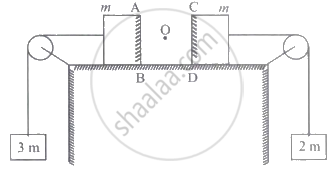Advertisements
Advertisements
प्रश्न
How long will it take a force of 10 N to stop a mass of 2.5 kg which is moving at 20 m/s ?
उत्तर
We are going to find acceleration
Force = mass × acceleration
`10 = 2.5 xx a`
⇒ `10/2.5 = a`
⇒ `(10 xx 10)/(2.5 xx 10) = a`
⇒ a = 4
Now , putting these values in the equation :
`v = u + at`
⇒ `20 = 0 + 4 xx t`
⇒ 20 = 4t
⇒ `20/4 = t`
⇒ `t = 5s`
APPEARS IN
संबंधित प्रश्न
A bullet of mass 10 g travelling horizontally with a velocity of 150 m s−1 strikes a stationary wooden block and comes to rest in 0.03 s. Calculate the distance of penetration of the bullet into the block. Also calculate the magnitude of the force exerted by the wooden block on the bullet.
The following is the distance-time table of an object in motion:
| Time in seconds | Distance in metres |
| 0 | 0 |
| 1 | 1 |
| 2 | 8 |
| 3 | 27 |
| 4 | 64 |
| 5 | 125 |
| 6 | 216 |
| 7 | 343 |
- What conclusion can you draw about the acceleration? Is it constant, increasing, decreasing, or zero?
- What do you infer about the forces acting on the object?
A hammer of mass 500 g, moving at 50 ms−1, strikes a nail. The nail stops the hammer in a very short time of 0.01 s. What is the force of the nail on the hammer?
A large truck and a car, both moving with a velocity of magnitude v, have a head-on collision and both of them come to a halt after that. If the collision lasts for 1 s:-
(a) Which vehicle experiences the greater force of impact?
(b) Which vehicle experiences the greater change in momentum?
(c) Which vehicle experiences the greater acceleration?
(d)Why is the car likely to suffer more damage than the truck?
State and explain Newton’s second law of motion.
If a balloon filled with air and its mouth untied, is released with its mouth in the downward direction, it
moves upwards. Why ?
State Newton’s second law.
Using the second law of motion, derive the relation between force and acceleration. A bullet of 10 g strikes a sand-bag at a speed of 103 m s-1 and gets embedded after travelling 5 cm. Calculate
(i) the resistive force exerted by the sand on the bullet
(ii) the time is taken by the bullet to come to rest.
A force vector applied on a mass is represented as `vecF = 6hati - 8hatj + 10hatk` N and accelerates the mass at 1 ms-2. The mass of the body is ______.
Two blocks each of mass m lie on a smooth table. They are attached to two other masses as shown in the figure. The pulleys and strings are light. An object O is kept at rest on the table. The sides AB and CD of the two blocks are plane and made reflecting. The acceleration of two images formed in those two reflecting surfaces with respect to each other is ______.

